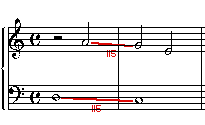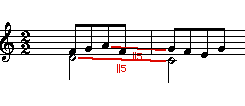These options can be selected in the "Independence" section of the Choose Style window when in Free Counterpoint.
Definitions: Two voices have similar motion if they both either ascend or descend. Similar motion is parallel if both voices move by the same interval. They have contrary motion if one ascends as the other descends, and their motion is oblique if one remains at the same pitch while the other changes pitch.
![]() Avoid parallel
fifths and octaves between adjacent notes. If two notes are separated
by a perfect fifth or octave and move in the same direction by the same
amount, they are creating parallel perfect intervals. These have traditionally
been considered to diminish the sense of independence of voices. Example:
Avoid parallel
fifths and octaves between adjacent notes. If two notes are separated
by a perfect fifth or octave and move in the same direction by the same
amount, they are creating parallel perfect intervals. These have traditionally
been considered to diminish the sense of independence of voices. Example:

 Allow if
syncopated.
Allow if
syncopated.
 Allow 5ths
if contrary and at least one voice is inner.
Allow 5ths
if contrary and at least one voice is inner.
 Allow
if at least one of the notes is "unessential." An "unessential" pitch
is one that is not part of the prevailing harmony. It may or may not
be dissonant. This applies more in tonal (18th century) than in modal
counterpoint.
Allow
if at least one of the notes is "unessential." An "unessential" pitch
is one that is not part of the prevailing harmony. It may or may not
be dissonant. This applies more in tonal (18th century) than in modal
counterpoint.
![]() Avoid parallel fifths
and octaves between any part of a beat and an accented note on the next beat.
This is a strict standard. An example:
Avoid parallel fifths
and octaves between any part of a beat and an accented note on the next beat.
This is a strict standard. An example:

 Allow if
the first notes don't begin simultaneously The syncopated effect would
tend to hide the parallel.
Allow if
the first notes don't begin simultaneously The syncopated effect would
tend to hide the parallel.
 Allow if both
first notes are offbeat.
Allow if both
first notes are offbeat.
 Allow if
intervening notes are concords. An intervening concord has traditionally
been thought to "save" a parallel.
Allow if
intervening notes are concords. An intervening concord has traditionally
been thought to "save" a parallel.
![]() Avoid parallel fifths
and octaves between notes on adjacent accents, if voices are 2:1 (second species).
Avoid parallel fifths
and octaves between notes on adjacent accents, if voices are 2:1 (second species).
 Allow if the
faster voice leaps by more than a third from the first perfect interval. Fux
(Mann, p. 43 f.) holds that such a leap distracts the ear from the parallel.
Allow if the
faster voice leaps by more than a third from the first perfect interval. Fux
(Mann, p. 43 f.) holds that such a leap distracts the ear from the parallel.
 Allow if intervening
note is concordant. In Fux's second species a leap to a dissonance is not
permitted, so this in effect relaxes the above Fux rule to include even concords
reached stepwise.
Allow if intervening
note is concordant. In Fux's second species a leap to a dissonance is not
permitted, so this in effect relaxes the above Fux rule to include even concords
reached stepwise.
![]() Avoid parallel fifths and
octaves between notes following adjacent accents, if voices are 2:1 (second species).
Avoid parallel fifths and
octaves between notes following adjacent accents, if voices are 2:1 (second species).
 Allow if each of
the notes forming the parallel is approached from a different direction.
Allow if each of
the notes forming the parallel is approached from a different direction.
 Allow if each of
the perfect intervals is "unessential" (not part of the prevailing harmony).
Allow if each of
the perfect intervals is "unessential" (not part of the prevailing harmony).
![]() Avoid "direct"or "hidden"
5ths or 8vas (similar motion to those intervals). Sometimes also called
"covered" fifths or octaves, these are harder to notice than parallels.
Avoid "direct"or "hidden"
5ths or 8vas (similar motion to those intervals). Sometimes also called
"covered" fifths or octaves, these are harder to notice than parallels.
 Allow if disguised
through syncopation.
Allow if disguised
through syncopation.
 Allow at cadence
in 3+ voices.
Allow at cadence
in 3+ voices.
 Allow if one voice
is inner and exposed voice moves by step. Bach does this fairly often in his Chorales.
Allow if one voice
is inner and exposed voice moves by step. Bach does this fairly often in his Chorales.
 Direct 5th allowed
in outer parts if upper voice moves by step. (But not the direct octave - just
fifths can use this exception).
Direct 5th allowed
in outer parts if upper voice moves by step. (But not the direct octave - just
fifths can use this exception).
 Direct 5th or 8va
allowed in outer parts if 4 or more voices and upper is by step.
Direct 5th or 8va
allowed in outer parts if 4 or more voices and upper is by step.
![]() Avoid leaping motion in two
voices moving to a perfect interval. This includes even contrary motion if
both voices move by leap.
Avoid leaping motion in two
voices moving to a perfect interval. This includes even contrary motion if
both voices move by leap.
 Allow if either is
an inner part.
Allow if either is
an inner part.
![]() Avoid similar motion in more
than two voices at once (impossible in more than 4 parts). If there are more
than four parts then of course three of them must be moving in similar or oblique motion.
Avoid similar motion in more
than two voices at once (impossible in more than 4 parts). If there are more
than four parts then of course three of them must be moving in similar or oblique motion.
![]() Avoid similar motion in outer
voices. This would be an impossible standard in two-part writing, but could be
accomplished in three or four parts.
Avoid similar motion in outer
voices. This would be an impossible standard in two-part writing, but could be
accomplished in three or four parts.
![]() Avoid similar motion from a
2nd to a 3rd. The smoothest resolution of the dissonance of a second comes when
the lower tone moves downward a step. This rule would stop you from writing an
awkward resolution involving an overlap, as follows:
Avoid similar motion from a
2nd to a 3rd. The smoothest resolution of the dissonance of a second comes when
the lower tone moves downward a step. This rule would stop you from writing an
awkward resolution involving an overlap, as follows:

![]() Avoid parallel fourths.
The fourth is has a double nature: it is the inversion of the consonant perfect
fifth, but acoustically its root is its upper note and due to instability it is
regarded as a discord when its lower tone is the bass. The perfect nature of the
interval raises the same objections as the fifth and octave if this interval is
written parallel. But when combined with the pitch class a third below its lower
tone it forms the familiar 1st inversion of a triad, and will then often be
seen written in a parallel sequence.
Avoid parallel fourths.
The fourth is has a double nature: it is the inversion of the consonant perfect
fifth, but acoustically its root is its upper note and due to instability it is
regarded as a discord when its lower tone is the bass. The perfect nature of the
interval raises the same objections as the fifth and octave if this interval is
written parallel. But when combined with the pitch class a third below its lower
tone it forms the familiar 1st inversion of a triad, and will then often be
seen written in a parallel sequence.
 Allow if combined
with a third below the lower tone:
Allow if combined
with a third below the lower tone:

 Allow if syncopated
Allow if syncopated
 Allow if at least
one of the notes is "unessential."
Allow if at least
one of the notes is "unessential."
![]() Avoid parallel major thirds
(owing to tritone effect). Two successive major thirds will produce a tritone
between the first note of the lower voice and the second note of the upper voice.
Yet this is sometimes found even in Palestrina:
Avoid parallel major thirds
(owing to tritone effect). Two successive major thirds will produce a tritone
between the first note of the lower voice and the second note of the upper voice.
Yet this is sometimes found even in Palestrina:
 Allow if no more
than two in succession.
Allow if no more
than two in succession.
![]() Avoid overlapping voices.
Voices are said to overlap when the lower one moves to a pitch at or above the
previous pitch of the higher voice. An example would be the similar motion of a 2nd
to a 3rd, as illustrated above.
Avoid overlapping voices.
Voices are said to overlap when the lower one moves to a pitch at or above the
previous pitch of the higher voice. An example would be the similar motion of a 2nd
to a 3rd, as illustrated above.
![]() Avoid crossing voices.
Crossing is more than an overlap; the lower voice becomes the higher, and vice-versa.
Crossing is sometimes forbidden just as an exercise, but Jeppeson (p. 113) remarks
that without crossing "no real polyphony is possible."
Avoid crossing voices.
Crossing is more than an overlap; the lower voice becomes the higher, and vice-versa.
Crossing is sometimes forbidden just as an exercise, but Jeppeson (p. 113) remarks
that without crossing "no real polyphony is possible."
 Allow crossing in
upper voices if more than two parts.This would be a sensible exception if you
want to try limiting crossing.
Allow crossing in
upper voices if more than two parts.This would be a sensible exception if you
want to try limiting crossing.
![]() Avoid more than 3 successive
uses of the same interval in the same voices (allowed in 3+ parts or when crossing).
One may be tempted to let two voices move in thirds or sixths continually, but if this
continues for long the independence of voices is lost.
Avoid more than 3 successive
uses of the same interval in the same voices (allowed in 3+ parts or when crossing).
One may be tempted to let two voices move in thirds or sixths continually, but if this
continues for long the independence of voices is lost.
![]() Avoid following a perfect
consonance with another one. Two voices forming a perfect fifth should not immediately
proceed to an octave, or vice-versa.
Avoid following a perfect
consonance with another one. Two voices forming a perfect fifth should not immediately
proceed to an octave, or vice-versa.
![]() Avoid unisons. This would be
most significant in two-part writing, though it may be desirable to try avoiding unisons
even in three and four parts.
Avoid unisons. This would be
most significant in two-part writing, though it may be desirable to try avoiding unisons
even in three and four parts.
 OK in an initial or a
final sonority.
OK in an initial or a
final sonority.
 OK for interior measures
if not the first note of measure. The first note of a measure would carry the most emphasis.
OK for interior measures
if not the first note of measure. The first note of a measure would carry the most emphasis.
©2011 Ars Nova Software, LLC